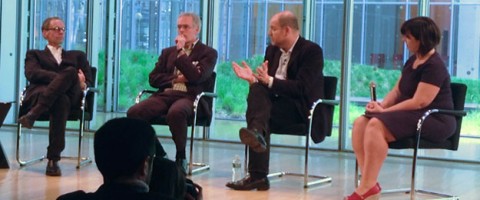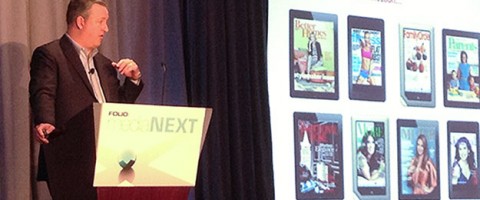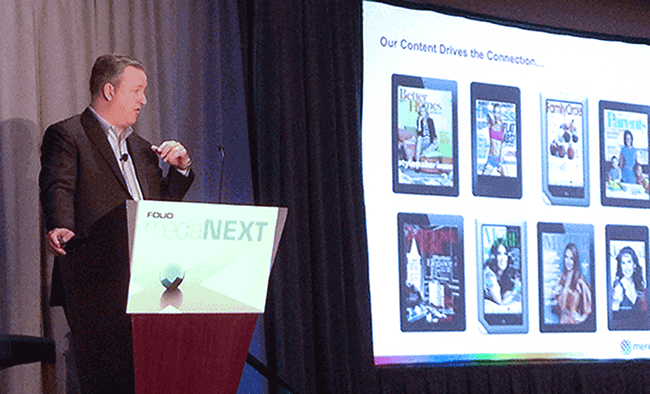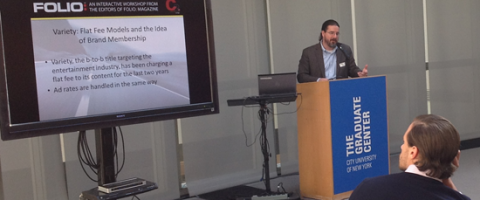Sharpening the editorial – advertising divide
The heat is on: Faced with a need to fatten revenues, publishers are pressing editors for marketing assistance. Blurring the line between content and advertising, though, can erode a reputation for impartiality valued by readers.
Magazines can avoid damage to their brands by establishing ethical guidelines. What should they be? Editors and writers attempted to answer that question during an Ethics Virtual Roundtable held by the ASBPE on June 12. Moderator Howard Rauch, Editorial Solutions, Inc., led a discussion on issues such as labeling sponsored sections, establishing suitable advisory board restraints, and dealing properly with freelance writers.
Mr. Rauch's report appears below.
Ethics News Update: At ASBPE's debut Ethics Virtual Roundtable, marketing involvement clearly was an important concern
 by Howard Rauch
by Howard Rauch
Editorial Solutions, Inc.
"I need ideas how I can reorganize the role of the editors to focus more on revenue generation. How is that possible without crossing the line between editorial and advertising, which already is blurred by more advertorials, cover tips, belly bands, etc?."
The above question, posed during ASBPE's Ethics Virtual Roundtable on June12, is a reflection of similar concerns on the minds of many attendees. This inquiry and many others involving a variety of issues were fielded by Ethics Committee members during the three one-hour conference calls scheduled that day. The following brief summary of information shared cannot replace the value of actually having attended the event.
There was extensive discussion about ethical issues pertaining to editor engagement in marketing activity. In the upcoming revised version of ASBPE's Guide to Preferred Editorial Practices, we will indicate that it's okay for senior editors to be engaged in planning advertorials or supplements. But when it comes to actual copy creation and source interviewing, such tasks should be executed by qualified freelance writers. At no time is it deemed acceptable for an article carrying a staff editor byline to appear as part of a sponsored content page or section.
We also spent some time on the issue of editorial quality deterioration -- not as much as I would have liked due to time constraints -- especially when it comes to digital content. In one recent poll conducted by my consulting company -- Editorial Solutions, Inc. -- several editors admitted that quality slippage had occurred due to to rapidly rising workloads.
I polled Roundtable attendees concerning ethical issues involving freelance/writer relationships because we wished to devote more space to that area in our Guide. The primary point of dispute appeared to be contractual agreements offered by publishers insisting that all rights to articles written by freelancers be surrendered.
Several registrants inquired about how sponsored sections with an editorial flavor should be labeled. Our ethics code already addresses this matter. For one thing, "advertorial" is not considered a proper ID. "Advertisement" or "sponsored section" are more appropriate labels. And of course, the content involved should use a graphic format clearly different from regular editorial content.
A point raised during a brief discussion about digital media was the need to establish a policy anticipating requests to "unpublish" content. If you've not yet had to deal with this matter, you can be sure the day will come when a prompt response will be required.
Several inquiries were posed by editors of association publications. The most controversial question addressed relationships with editorial boards and the best way to educate them on the value of editorial excellence and independence.
Two aspects of this dilemma were addressed by ASBPE Ethics Committee representatives: (1) Advisory boards are just that; in no way should members be allowed to dictate editorial policy; (2) sometimes disputes with board members can only be resolved via a readership study. In one case where this step was taken, results showed that some coverage board members were pressing for was of the least interest to survey respondents.
Attendees submitted several questions immediately following the event. The most interesting inquiry: Should editorial staff give its sales team a pre-publication list of vendor sources mentioned in upcoming product-oriented articles?
The answer provided was based on my consulting experience and does not necessarily reflect ASBPE policy: Of course, procedures followed depend upon the circumstances. For example, let's say you have a round-up feature focusing on product category X. At some firms, before interviews begin, editors confer with the publisher in terms of vendor sources that should be approached, sources that might be approached, and sources to be downplayed.
Mosf of the time, this is not a troublesome practice because industry leaders you'd want to interview would fall into the "should be" category. On the other hand, it's tough to ignore a top company not an advertiser that lands in the "might be" or "downplay" category. When that occurs, the publisher's directive should be disputed.
Then . . . it also is practice in some firms that when all sources have been interviewed, a list of those mentioned in an upcoming article should be provided to the publisher so the companies identified can be pitched for advertising.
As you can see, the above remarks reflect today's reality that many issues preceived as ethical dilemmas overlap with traditional marketing practice. A few B2B editors have chosen to address these matters via written policy covering a variety of situations under the banner of staff relationships with advertisers.
Moving away from the marketing area, two useful information sources deserve follow-up:
(1) Business Travel News Editorial Guidlines. This very useful list covers news gathering and reporting, external relationships, gifts and travel as well as an interesting "embargo" practice. View this list at www.businesstravelnews.com/Editorial-Guidelines/.
(2) Best practice guidelines for editors crafting social media policies. This excellent report prepared by the American Society of Newspaper Editors was referenced in a previous Ethics News Update. "Best Practices . . . " includes a list of ten key takeaways plus social media excerpts from several dailies. Go to www.asne.org, hit the resources link and then the "social media" link.
I'd like to thank Ethics Committee representatives who helped me field attendee inquiries: Paul Heney, Roy Harris, Abe Peck and Robin Sherman. Attendance at this initial Roundtable was excellent. Those of you who missed the event really should try harder to set aside an hour for future Virtual Roundtables.
Thriving in a “Twitter First” World
Twitter: Easy, rough and raucous. Journalism: Tough, refined and reflective. Can a marriage of this odd couple endure?
If the answer is “no,” it won’t be for lack of interest in a meaningful relationship. Attracted by Twitter’s rapidly growing hegemony over breaking news, publishers are struggling to thread the social medium’s chaotic feeds into legacy media’s fabric. The result is a 21st century amalgam, an uneasy alliance in which Tweets and video clips disrupt and enhance their print progenitor.
“We are seeing a fascinating morphing from the traditions of journalism,” said Mark Thompson, president and chief executive of The New York Times. “It’s broadcasting, but it’s different from broadcasting. It’s multi media, a real time cooking up and grabbing of lots of diverse textures and experiences. It has a very real time immediacy and urgency, but there’s also a lot of character in it.”
Twitter first
Thompson presented his analysis during “The Future of News Organizations in an Increasingly Social World,” a discussion held during Social Media Summit 2013 sponsored by The New York Times and BBC Academy’s College of Journalism. Participants were (pictured left to right) David Carr (moderator), Media Columnist for the New York Times; Peter Horrocks, Director of Global News at the BBC; The New York Times’s Thompson; and Janine Gibson, Editor in Chief of Guardian U.S.
The conference was held a day after the April 19 apprehension of the second Boston bombing suspect, the culminating event in what Carr described as “an extraordinary week of domestic news.” Media old and new responded to the rapidly developing story with a nervous stutter of cooperation and tension characteristic of the developing communications paradigm. “Sometimes traditional and social media feeds would morph into one another,” noted Carr. “And sometimes they would diverge and be in conflict.”
What was most apparent from the Boston reporting, though, was that Twitter has taken the lead as the first source of breaking news. “For the first time continuous TV news has come in second,” said Thompson. “Now, essentially, Twitter is first.”
Assess and enhance
First it may be, but Twitter, in its rush to report, can mislead with rumor as well as fact. “Twitter presents everything on an equivalent basis,” noted Horrocks. The danger, of course, is the temptation to rebroadcast a juicy but inaccurate Tweet. Responding to pressures from an eager public and competitive news outlets, reporters can producing copy that harms the public and the media’s reputation. “A lot of professional journalists go to Twitter to blame Twitter,” said Gibson. “But all the catastrophic things that were wrong in the Boston reporting were done by news organizations failing to report properly. If you apply the right reporting principles to your sources, whether from Twitter or otherwise, you should not get into that much trouble.”
Reporters will continually be confronted with the grey area of raw information compelling enough to warrant broadcast but absent sufficient validation. In such cases news organizations can hedge their reporting with appropriate language, employing the equivalent of what Carr called “a digital ten foot pole so you can have it but not be blamed for it.”
Hedged or not, news stories will be more authentic when the reporter has taken time for reflection. Here American journalism might learn something from its more careful British counterpart. “We know it’s best to wait, not to follow that thing from Twitter right away,” said Gibson. “We get our best people and coolest heads running the outfit, and then we say what we can see as clearly as possible.”
Successful gatekeeping requires a skill set that differs from that of traditional reportage. “The effect of stream based journalism, the need to compress things and deal with context and atomization, is in many ways more of a challenge than selecting sources and making the right judgments,” said Horrocks. “It changes the way you write and package your journalism.” The value of such curating is not lost on those flying with the social media flock. “A lot of people on Twitter are saying ‘old media is dead,’” said Carr. “But their feeds are full of links to legacy reporting.”
Open doors
In the best of cases Twitter becomes more than a valuable source of news feeds. It also enlarges the audience for traditional publishing formats. This is occurring at the BBC where reporters with hot news items are instructed to “text first” and write second. “We changed our policy a year ago from a requirement to break news first in a radio or TV broadcast piece,” said Horrocks. “All journalists now file first in text, which is the best way to get information to all of our platforms.”
The system is designed so that posts go out concurrently on BBC and individual Twitter timelines. The BBC’s audience is increased when timeline readers click URLs which take them to the legacy media’s website for stories analyzing the news. “Twitter is absolutely a friend,” said Horrocks. “It’s totally transforming the kind of journalism we are doing around the world.”
Social media can extend a media’s brand in even more dramatic ways. “Today with Facebook we are having a conversation with our audience in Burma,” said Horrocks. “That hasn’t been possible for 40 years. A group of journalists exiled in London has been broadcasting many thousands of miles away with very little information from that country. Now all of a sudden we are able to have a conversation with people there about the country’s future.”
Building the audience
If social media draw new people to a legacy brand’s website, will they stick? “How you go from a first referral from a social environment to a story at nytimes.com, and then keep readers there, drawing them in to take one more story, is the big issue,” said Thompson. Part of the answer is encouraging visitors to open a dialog with the text. “We know that people who take the time to comment are more likely than others to become subscribers,” said Thompson. “Eighty percent of the people who comment the most are subscribers.”
Publishers must also package editorial in a format that exploits the characteristic engagement of reader and device. “If we panned a camera around the audience here we would find that from 30 to 40 percent of people are using smart phones and small laptops,” said Thompson. “We need to think about the behaviors that go with these different form factors, then work out the best way to put content in front of people. We need to create really effective, clever, attractive environments which make the best use of the screen and the rest of the device.” High quality apps are part of that environment. “You can already feel that people do not want 900 apps, but a smaller number that do what they do excellently,” said Thompson.
There is a special challenge in designing appropriately for the idiosyncratic interface of the tablet. “We need to be careful with the tablet,” said Thompson. “We have all ended up with rather static, rather beautiful near facsimiles of our print products. Very few news providers are using tablets for what they can do with multimedia, sound and the moving picture.”
Such as? One example of what can be done is “Snowfall.” Written by John Branch, this report of a Washington state avalanche is, in Thompson’s words, “a fantastic mixture of a brilliant piece of text with the dropping in of intense personal experiences in amazing animated graphics.”
The bottom line
Visually stimulating. Exciting. Compelling. All of these descriptions apply to the marriage of legacy and social media. But will the partnership succeed in financial terms? There’s no doubt that a positive answer will require experimentation. Carr held up his smart phone to illustrate the challenge. “I do not see room here for a business model. It’s little. If news becomes a list, I worry that social will become the operating system in a news environment, to the detriment of media brands.”
A more sanguine view was offered by the Guardian’s Gibson: “I am old enough to remember when our lunch was going to be eaten by the Internet,” she said. “That didn’t happen. You have to have faith that you are producing something that is brilliant and appropriate to the medium. Then you will figure out how to fund it and scale your costs accordingly.”
Photo and story by Phillip M. Perry
May 29, 2013
B-to-B’s Path to Mobile Optimization – B2B @ FolioMag.com
Traffic for business content—traditionally living in the 9 to 5 world of desktops—has risen considerably on mobile devices. And that base is only getting bigger. Business publications expect more than a quarter of their audiences to access content exclusively on digital platforms within the next two years, according to a recent study by the Alliance for Audited Media (AAM).
But even though they see the rising tide of mobile users, b-to-b publishers aren’t sure how to proceed. The same AAM study reports that 60 percent are undecided about how exactly they’ll optimize for mobile. Meanwhile, close to two-thirds of consumer magazines already have a definitive approach.
B-to-b publishers ALM and FierceMarkets have begun to take significant steps to optimize their content for mobile consumption though. Both have rolled out the changes incrementally, but they’re each being careful to address the full spectrum of the user experience. Having a disjointed, part-mobile, part-desktop device strategy puts a ceiling on your mobile potential.
Read complete article by Michael Rondon:
Connecting with Consumers in Digital Times
How does a magazine publishing company survive and thrive in the digital age? By changing with the times without betraying its core mission. On the one hand the company must engineer editorial to meet the requirements of delivery channels such as social media and mobile apps, molding its product to conform to and exploit the limitations and potentialities of tablets and cell phones. On the other hand the publisher must maintain and exceed a level of editorial integrity and service that over the years have built core audience loyalty.
Known for its century-old titles such as Better Homes and Gardens and Ladies Home Journal, Meredith has been engaging in a modern day balancing act, reengineering content for the digital age while maintaining firm control over reader-focused editorial.
“For our company to keep growing we must keep thinking about how our magazine brands can connect with consumers in new ways,” said Tom Harty, President of the company’s National Media Group. Speaking at a Folio Magazine conference earlier this year, Harty illustrated the importance of digital delivery with an arresting fact: “65 percent of magazine lovers aged 18 to 34 follow a magazine editor or columnist on Twitter.”
Responding to consumer demand for multi channel delivery, the Better Homes and Gardens brand has expanded from its print origins into tablet, web sites, and mobile apps. The response has been enthusiastic, said Harty. “Technology has changed the conversation we have with consumers. Readers can now interact with our brands how and when they want to. Today almost half our connection with readers is through some sort of digital channel.”
Mobile rules
For many people, the word “digital” conjures up images of web sites. But in many cases the fastest growing digital channel is mobile, a term which embraces tablet and smart phone access. Consider the after effects of Meredith’s acquisition of allrecipes.com a year ago, a move which doubled the company’s digital footprint in Meredith’s number one content area: food. “At the time we acquired allrecipes.com 15 percent of the site’s traffic was mobile,” said Harty. “Today, after a period of less than 12 months, mobile represents 50 percent of the site’s access. And half of that traffic is happening inside a store. This is a tremendous change.”
The consumer’s embrace of mobile explains why the company’s motto is now “change plus innovation equals sustained growth,” said Harty. “Change is an opportunity to grow our brands.”
Even so, change for its own sake can backfire. Indeed, the company must not get ahead of its audience. “We know that only two to three percent of our women have switched to the tablet format,” said Harty. “We realized that simply being the first to market was not critical at this stage of the technology. It was more important to focus on delivering the content in the most appropriate format for our audiences.”
If the tablet transformation is gradual, it is sure. “We are working hard to bring our brands into the tablet era. We are true believers.”
King Content
In this royal court of publishing the Crown may be digital but the King is content. “We are not a technology products company,” Harty emphasized. “We are a content company. The curated and trusted content of our magazines and our digital media drive our connection with our core audience of 100 million women. At the end of the day we have to deliver on our brand promise.” The “crux” of Meredith’s strategy to fulfill that promise is the provision of content aligned with what Harty describes as the “three main focuses” of the company’s readers: family, home and well being.
Indeed, the house of Meredith is built upon a foundation of magazines in their ideal form of molded content. “I have to remind everyone at Meredith and in the industry how many people still love magazines,” said Harty. He offered supporting MPA numbers: “Magazines are witnessing unprecedented strong growth among consumer audiences. Print magazines are read by nine out of 10 adults and 95 percent of adults 18 to 24.”
That loyalty translates into dollars. “Consumers spend more than $300 million a month to buy magazines at the news stand,” said Harty. “And the number of brands advertising in magazines has increased 57 percent in last two years.”
Meredith’s own numbers reflect a continuing interest in magazines. “Our total magazine audience is 116 million,” said Harty. “Never before in our history have our magazines reached such a large audience. During the worst economic recession in two generations our subscription business has never been better. We are constantly reinvesting in our magazines and brands to make sure we are best in class.”
Editorial Dialog
At one level, the modern multi-channel approach has fundamentally changed Meredith’s dynamic with advertisers. Today a single sponsor might purchase a package that communicates a message through several related magazines in a number of print and digital channels. The result is a more powerful and compelling offer. “It’s not about selling ad pages anymore,” said Harty. “It’s not about selling digital banner ads. It’s about selling client solutions across many platforms.”
Equally compelling is the transformation in editorial. Mature and seasoned as it is, content continues to evolve in subtle ways as readers exploit technology to gain an interactive presence. “In today’s media world people view your brands more as a daily content experience,” said Harty. Escalating patterns of reader interactivity offer opportunities for a closer engagement of editorial with consumer needs.
Harty offered one example. “We recently reinvented the Ladies Home Journal brand, fueled by social media. The traditional way LHJ was created was that editors would sit around a table, decide what they thought was important to their readers, and create content. Hopefully readers would read something that they found interesting.”
The new editorial model allows readers to involve themselves with the content in a much more intimate way. “Social media sites are leveraged to start the conversation with readers before we actually create the magazine content,” said Harty. “These conversations fuel the brand with what really matters to its readers and help develop the original content. The editorial teams use this fuel along with their trusted expertise and external advisors and internal experts to expand ideas and fill LHJ with socially fueled vibrant content.”
The initiative has succeeded. “Over the past nine months the model has been unbelievably responded to,” said Harty. “The result has been the transformation of one of our oldest brands. We knew it would be a challenge but we also knew this brand has always been driven by highly engaged conversations with readers.”
As Meredith applies this methodology to other magazine properties it is illustrating a bright path for publishing houses to flourish in the digital age. In the process the company has transformed itself, in Harty’s words, “from a traditional print publishing company into a national marketing communications organization.”
Article and photo: Phillip M. Perry
Electronic media bring 15-18% of revenues

Bill Mickey, editor of Folio
The New York City seminar was presented in November by Folio magazine editor Bill Mickey (pictured). Also in attendance was Tony Silber, Folio general manager.
“The business model is not predictable anymore and we will be living with that the rest of our careers,” said Silber, speaking of the rapidly changing digital environment. “Every 18 months we will be asking ‘What's the next big thing?’”
Among the seminar highlights:
* Digital accounts for some 20 percent of b2b (business-to-business) advertising revenues today,
* Only 11 percent of b2b publishers believe their digital strategy is fully developed.
* B2b publishers are more sanguine than consumer publishers about print advertising.
Tony Silber, Folio general manager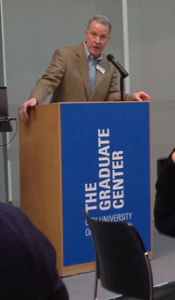
* Revenues from electronic media have not replaced revenue lost from print.
* Newsstand sales have lost 40 percent of their value in the last 10 years.
* Mobile is growing quickly; about one third of magazine websites are mobile enabled.
* Magazines are running more sponsored stories from advertisers. “Putting advertising into the content flow is the newest trend,” says Silber.

